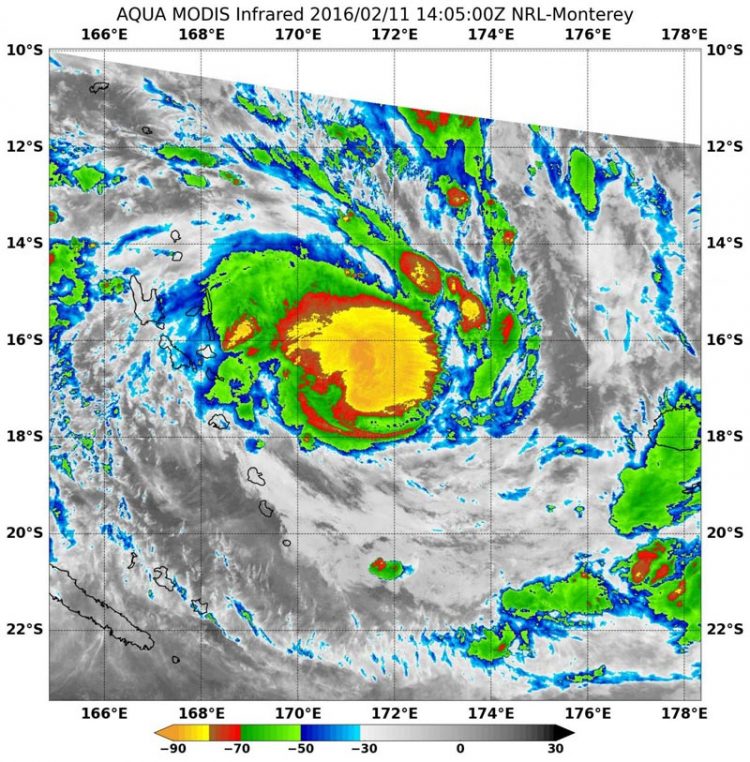NASA sees Tropical Cyclone Winston form

On Feb. 11 at 1405 UTC (9:06 a.m. EST), the MODIS instrument aboard NASA's Aqua satellite saw coldest cloud top temperatures near -80F/- 62.2C and strongest storms circling the center of Tropical Cyclone Winston. Credit: Credits: NASA JPL, Ed Olsen
On Feb. 11 at 1405 UTC (9:06 a.m. EST), the MODIS instrument aboard NASA's Aqua satellite saw coldest cloud top temperatures near minus 80 degrees Fahrenheit/ minus 62.2 degrees Celsius indicating very powerful storms circling the center of Tropical Cyclone Winston.
Those powerful storms are spiraling into the low-level center of circulation. Storms with cloud tops that cold and high in the troposphere have been shown to generate heavy rainfall.
Infrared data also showed that sea surface temperatures were near 31 degrees Celsius warm enough to keep fueling and strengthening the storm. Tropical cyclones need sea surface temperatures of at least 26.6 degrees Celsius (80 degrees Fahrenheit) to maintain intensity.
At 1500 UTC (10 a.m. EST), Winston's maximum sustained winds were near 55 knots (63.2 mph/101.9 kph). It was centered near 16.7 degrees south latitude and 171.6 degrees east longitude, about 398 nautical miles west of Suva, Fiji. Winston was moving to the south-southeast at 6 knots (6.9 mph/11.1 kph).
Winston is forecast to move south and continue between Vanuatu to the west and Fiji to the east while intensifying to 105 knots (120.8 mph/194.5 kph).
Media Contact
All latest news from the category: Earth Sciences
Earth Sciences (also referred to as Geosciences), which deals with basic issues surrounding our planet, plays a vital role in the area of energy and raw materials supply.
Earth Sciences comprises subjects such as geology, geography, geological informatics, paleontology, mineralogy, petrography, crystallography, geophysics, geodesy, glaciology, cartography, photogrammetry, meteorology and seismology, early-warning systems, earthquake research and polar research.
Newest articles

Webb captures top of iconic horsehead nebula in unprecedented detail
NASA’s James Webb Space Telescope has captured the sharpest infrared images to date of a zoomed-in portion of one of the most distinctive objects in our skies, the Horsehead Nebula….

Cost-effective, high-capacity, and cyclable lithium-ion battery cathodes
Charge-recharge cycling of lithium-superrich iron oxide, a cost-effective and high-capacity cathode for new-generation lithium-ion batteries, can be greatly improved by doping with readily available mineral elements. The energy capacity and…

Novel genetic plant regeneration approach
…without the application of phytohormones. Researchers develop a novel plant regeneration approach by modulating the expression of genes that control plant cell differentiation. For ages now, plants have been the…





















